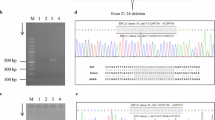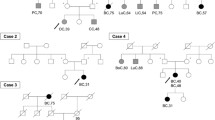Abstract
Background
BRCA1 and BRCA2 are two major tumor suppressor genes for hereditary breast and ovarian cancer. In sporadic breast cancer, although somatic mutations of these genes are rare, loss of heterozygosity (LOH) at BRCA1 and BRCA2 loci is common.
Methods
LOH at BRCA1 and BRCA2 loci were investigated in 202 Japanese invasive breast cancer patients. The relationships between LOH at these gene loci and clinicopathologic characteristics were analyzed.
Results
Among 166 informative cases for both BRCA1 and BRCA2 loci, 69 (41.6%) and 52 (31.3%) tumors revealed LOH at BRCA1 and BRCA2 loci, respectively. LOH at BRCA1 LOH or BRCA2 locus was associated with higher nuclear grade (P < 0.0001, P = 0.0187). LOH at BRCA1 locus was associated with estrogen receptor and progesterone receptor negativity (P = 0.001 and P = 0.015) and significantly shorter disease-free survival (P < 0.0001), distant metastasis-free survival (P < 0.0001), and overall survival (P < 0.0001). In contrast, LOH at BRCA2 locus had no associations with estrogen receptor or progesterone receptor status and prognosis. LOH at BRCA1 locus was independently associated with poor prognosis in terms of disease-free survival (hazard ratio 3.08, 95% confidence interval [CI] 1.58–6.18, P = 0.0009), distant metastasis-free survival (hazard ratio 5.18, 95% CI 2.35–12.19, P < 0.0001), and overall survival (hazard ratio 4.97, 95% CI 1.84–15.1, P = 0.0013).
Conclusions
LOH at BRCA1 locus could be an independent prognostic biomarker useful in identifying a subgroup of patients with poor prognosis.


Similar content being viewed by others
References
Wooster R, Weber BL. Breast and ovarian cancer. N Engl J Med. 2003;348:2339–47.
Turner N, Tutt A, Ashworth A. Hallmarks of “BRCAness” in sporadic cancers. Nat Rev Cancer. 2004;4:814–9.
Venkitaraman AR. Cancer susceptibility and the functions of BRCA1 and BRCA2. Cell. 2002;108:171–82.
Tutt A, Ashworth A. The relationship between the roles of BRCA genes in DNA repair and cancer predisposition. Trends Mol Med. 2002;8:571–6.
Callahan R, Cropp C, Sheng ZM, et al. Definition of regions of the human genome affected by loss of heterozygosity in primary human breast tumors. J Cell Biochem Suppl. 1993;17G:167–72.
O’Donovan PJ, Livingston DM. BRCA1 and BRCA2: breast/ovarian cancer susceptibility gene products and participants in DNA double-strand break repair. Carcinogenesis. 2010;31:961–7.
Merajver SD, Pham TM, Caduff RF, et al. Somatic mutations in the BRCA1 gene in sporadic ovarian tumours. Nat Genet. 1995;9:439–43.
Futreal PA, Liu Q, Shattuck-Eidens D, et al. BRCA1 mutations in primary breast and ovarian carcinomas. Science. 1994;266:120–2.
Lancaster JM, Wooster R, Mangion J, et al. BRCA2 mutations in primary breast and ovarian cancers. Nat Genet. 1996;13:238–40.
Santarosa M, Ashworth A. Haploinsufficiency for tumour suppressor genes: when you don’t need to go all the way. Biochim Biophys Acta. 2004;1654:105–22.
Miller BJ, Wang D, Krahe R, Wright FA. Pooled analysis of loss of heterozygosity in breast cancer: a genome scan provides comparative evidence for multiple tumor suppressors and identifies novel candidate regions. Am J Hum Genet. 2003;73:748–67.
Staff S, Isola J, Tanner M. Haplo-insufficiency of BRCA1 in sporadic breast cancer. Cancer Res. 2003;63:4978–83.
Beckmann MW, Picard F, An HX, et al. Clinical impact of detection of loss of heterozygosity of BRCA1 and BRCA2 markers in sporadic breast cancer. Br J Cancer. 1996;73:1220–6.
Gonzalez R, Silva JM, Dominguez G, et al. Detection of loss of heterozygosity at RAD51, RAD52, RAD54 and BRCA1 and BRCA2 loci in breast cancer: pathological correlations. Br J Cancer. 1999;81:503–9.
Hanby AM, Kelsell DP, Potts HW, et al. Association between loss of heterozygosity of BRCA1 and BRCA2 and morphological attributes of sporadic breast cancer. Int J Cancer. 2000;88:204–8.
Schmutzler RK, Bierhoff E, Werkhausen T, et al. Genomic deletions in the BRCA1, BRCA2 and TP53 regions associate with low expression of the estrogen receptor in sporadic breast carcinoma. Int J Cancer. 1997;74:322–5.
Charef-Hamza S, Trimeche M, Ziadi S, et al. Loss of heterozygosity at the BRCA1 locus in Tunisian women with sporadic breast cancer. Cancer Lett. 2005;224:185–91.
Silva JM, Gonzalez R, Provencio M, et al. Loss of heterozygosity in BRCA1 and BRCA2 markers and high-grade malignancy in breast cancer. Breast Cancer Res Treat. 1999;53:9–17.
Katsama A, Sourvinos G, Zachos G, Spandidos DA. Allelic loss at the BRCA1, BRCA2 and TP53 loci in human sporadic breast carcinoma. Cancer Lett. 2000;150:165–70.
Querzoli P, Albonico G, di Iasio MG, et al. Biophenotypes and survival of BRCA1 and TP53 deleted breast cancer in young women. Breast Cancer Res Treat. 2001;66:135–42.
Yamashita T, Iwase H, Yamashita i, et al. Low frequency loss of heterozygosity in the BRCA1 region in Japanese sporadic breast cancer. Breast Cancer. 1996;3:167–72.
Hampl JA, Hampl M, Reiss G, Koch R, Saeger HD, Schackert HK. Loss of BRCA2 correlates with reduced long-term survival of sporadic breast cancer patients. Anticancer Res. 2004;24:281–90.
Cleton-Jansen AM, Collins N, Lakhani SR, et al. Loss of heterozygosity in sporadic breast tumours at the BRCA2 locus on chromosome 13q12–q13. Br J Cancer. 1995;72:1241–4.
van den Berg J, Johannsson O, Hakansson S, Olsson H, Borg A. Allelic loss at chromosome 13q12–q13 is associated with poor prognosis in familial and sporadic breast cancer. Br J Cancer. 1996;74:1615–9.
Oda S, Oki E, Maehara Y, Sugimachi K. Precise assessment of microsatellite instability using high resolution fluorescent microsatellite analysis. Nucleic Acids Res. 1997;25:3415–20.
Tokunaga E, Oki E, Oda S, et al. Frequency of microsatellite instability in breast cancer determined by high-resolution fluorescent microsatellite analysis. Oncology. 2000;59:44–9.
Johnson SM, Shaw JA, Walker RA. Sporadic breast cancer in young women: prevalence of loss of heterozygosity at p53, BRCA1 and BRCA2. Int J Cancer. 2002;98:205–9.
Oki E, Baba H, Tokunaga E, et al. Akt phosphorylation associates with LOH of PTEN and leads to chemoresistance for gastric cancer. Int J Cancer. 2005;117:376–80.
Tokunaga E, Oki E, Kimura Y, et al. Coexistence of the loss of heterozygosity at the PTEN locus and HER2 overexpression enhances the Akt activity thus leading to a negative progesterone receptor expression in breast carcinoma. Breast Cancer Res Treat. 2007;101:249–57.
Tokunaga E, Kimura Y, Oki E, et al. Akt is frequently activated in HER2/neu-positive breast cancers and associated with poor prognosis among hormone-treated patients. Int J Cancer. 2006;118:284–9.
Huen MS, Sy SM, Chen J. BRCA1 and its toolbox for the maintenance of genome integrity. Nat Rev Mol Cell Biol. 2010;11:138–48.
Sorlie T, Tibshirani R, Parker J, et al. Repeated observation of breast tumor subtypes in independent gene expression data sets. Proc Natl Acad Sci U S A. 2003;100:8418–23.
Tutt AN, van Oostrom CT, Ross GM, van Steeg H, Ashworth A. Disruption of Brca2 increases the spontaneous mutation rate in vivo: synergism with ionizing radiation. EMBO Rep. 2002;3:255–60.
Tutt A, Bertwistle D, Valentine J, et al. Mutation in Brca2 stimulates error-prone homology-directed repair of DNA double-strand breaks occurring between repeated sequences. EMBO J. 2001;20:4704–16.
Acknowledgment
We are grateful to M. Makikusa and T. Shishino, M. Kiyota, and Y. Kubota for their valuable technical assistance. This study was supported by grants from the Ministry of Education, Culture, Sports, Science, and Technology of Japan.
Author information
Authors and Affiliations
Corresponding author
Rights and permissions
About this article
Cite this article
Okada, S., Tokunaga, E., Kitao, H. et al. Loss of Heterozygosity at BRCA1 Locus Is Significantly Associated with Aggressiveness and Poor Prognosis in Breast Cancer. Ann Surg Oncol 19, 1499–1507 (2012). https://doi.org/10.1245/s10434-011-2166-5
Received:
Published:
Issue Date:
DOI: https://doi.org/10.1245/s10434-011-2166-5




